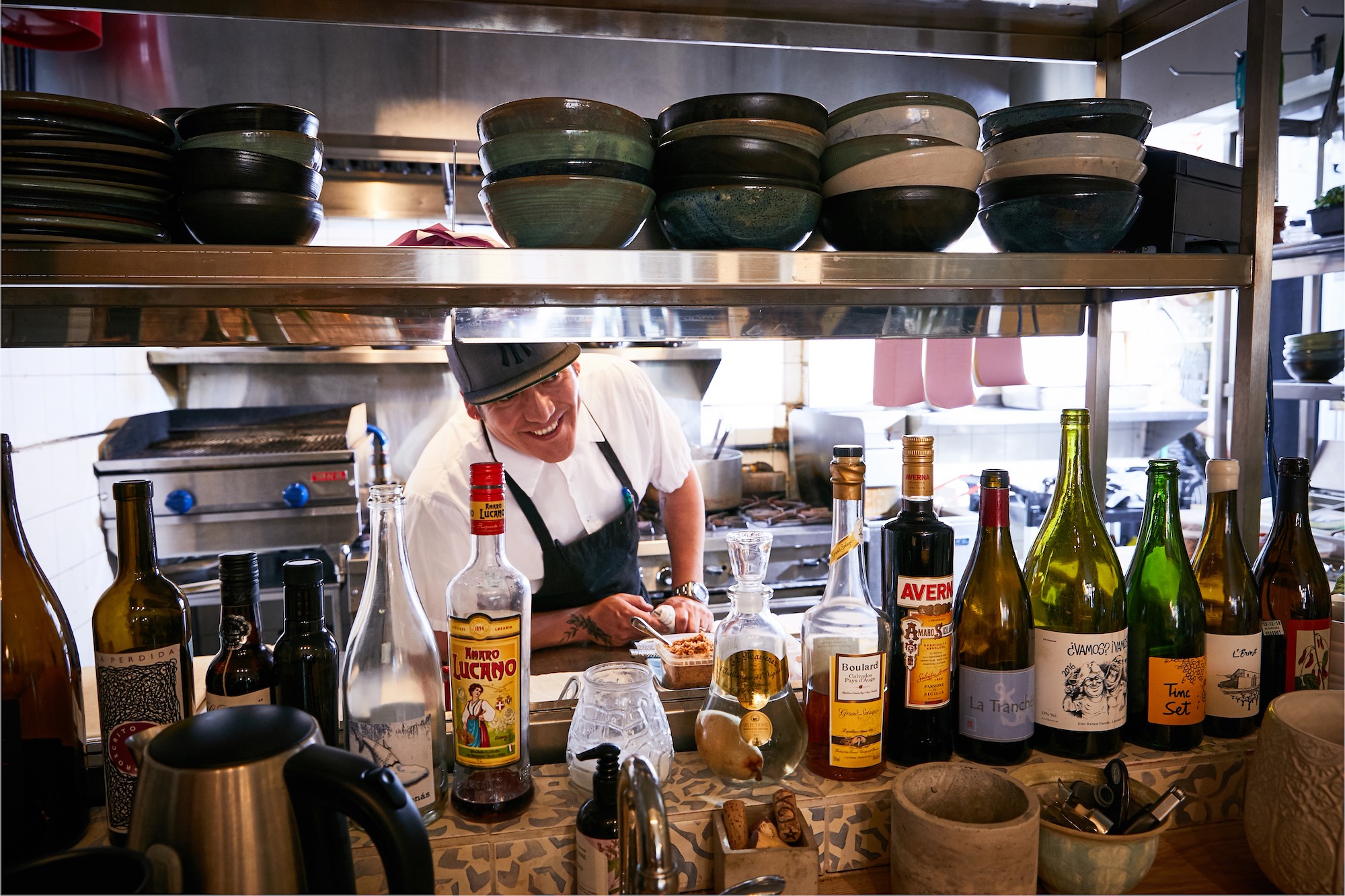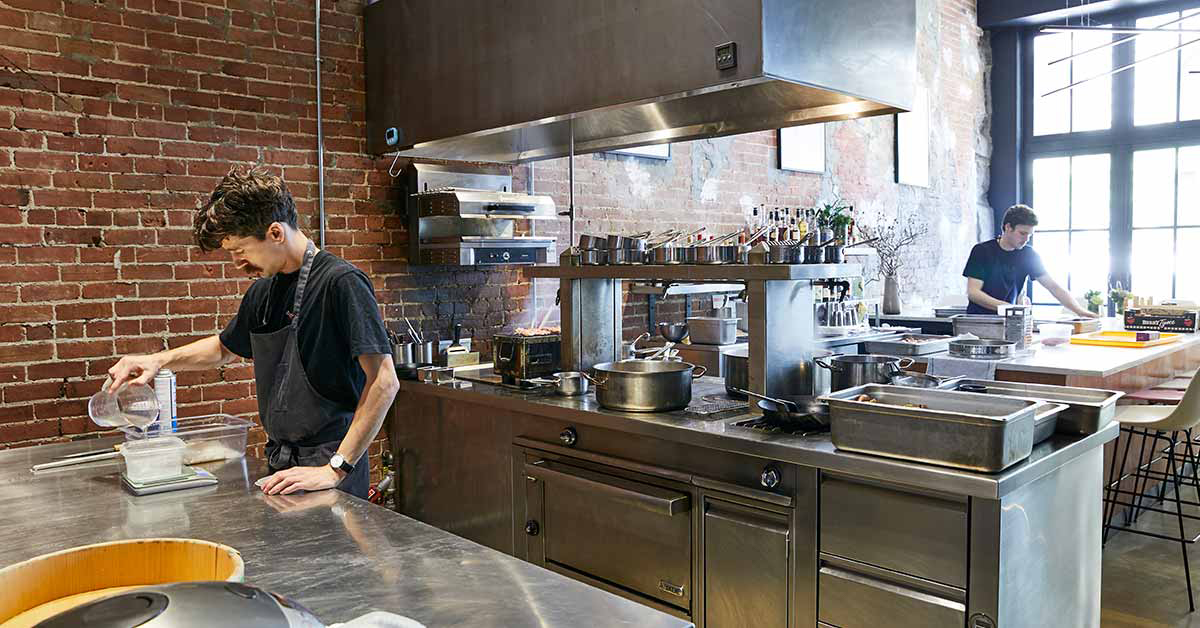
When it comes to opening a restaurant, startup costs can add up fast. Along with your commercial space lease, licenses, permits and marketing expenses, your list of restaurant equipment is one of the main startup costs to plan for.
You want to equip your servers, hosts and kitchen staff with the tools they need to get the job done day in and day out.
But which tools are essential?
In this article we’ll cover:
- What is restaurant equipment
- Essential restaurant kitchen equipment checklist
- Financing & buying kitchen tools and equipment
- What to consider before purchasing kitchen tools and equipment
The point of sale system for your restaurant
Manage your entire restaurant from one place. Offer tableside ordering, faster payments and more with the leading point of sale system for restaurants.
What is restaurant equipment?
Restaurant equipment refers to the tools and appliances used in a commercial kitchen to prepare, cook and serve food. It includes everything from kitchen appliances and utensils (such as ovens, refrigerators, food storage containers) to hardware and software (like kitchen display & point of sale systems).
Essential restaurant kitchen equipment checklist
The exact tools and equipment your restaurant will need would depend on what type of food you serve and what type of service you run; a full-service restaurant doesn’t have the same needs as a quick-service burger joint. The tools you’ll end up buying will also depend on your budget. Restaurant equipment can cost anywhere from $75,000 to $115,000. With that said, there is some overlap between the equipment each restaurant needs.
Below is a comprehensive checklist that covers the essential kitchen equipment used by most restaurants.
1. Ovens
The oven is a central piece of commercial kitchen equipment in your arsenal. The type of oven you’ll need will depend largely on the type of restaurant and the food you will be serving. If you own a bakery, you might not need the same type of oven as a fine-dining restaurant.
Choosing an oven can be a long process, which is why it’s important to know what to look out for. Keep these factors in mind when choosing the right oven for your restaurant:
Size
The amount of space you have in your kitchen will determine the size of oven you should look for. Sitting down and crafting out your commercial kitchen layout will help you know how much space you actually have for your oven. Another important point is to think about how much food you are planning on preparing during a service to figure out what capacity you need.
Quality
Your oven and range are the heart of your kitchen, so choosing something that can withstand the tests of time and use, can be the difference between success and failure. Make sure you take a look at the different brands, reviews, warranty and service agreements that might come with it.
Function
This will largely depend on the type of cooking you are planning on doing at your restaurant. The first step is to decide if you’ll want an electric or a gas stove. The next step is to figure out the type of oven you need. If you’re opening a bakery or a coffee shop, your requirements will be different than a fine dining restaurant.
Types of ovens
The type of oven (or ovens!) you need is going to depend largely on what you will be serving. Before starting your search, make a list of the types of foods you envision serving and this will help narrow your options.
- Commercial oven. Most restaurants will have at least one commercial or standard oven. This type of oven is great for even-style cooking and ideal for baked dishes. Consider this a must for most restaurants.
- Convection oven. Unlike commercial ovens, these ovens have fans that help circulate hot air. A convection oven is essential for bakeries and ideal for baking things like bread, pastries, pies and cookies, as well as toasting, roasting and dehydrating.
- Combination oven. The combination oven is a mix of a convection oven and a steamer. The main plus of this type of oven is its versatility. With a combination oven, you can roast, steam, smoke, fry, bake or grill. You name it, the combi oven can do it.
- Pizza oven. As the name suggests, this type of oven is used for making pizzas. Because of its high temperature, its use is not limited to just pizza making. With a pizza oven you can also handle anything from desserts to meats.
- Conveyor Oven. You’ve probably seen this type of oven at your neighborhood sandwich or pizza shop. In a conveyor oven, food passes through a conveyor belt where it heats up or gets cooked at a certain pace and heat
2. Ranges and ventilation
Once you’ve sorted the ovens out, you’ll want to start thinking of your ranges and ventilation. Your ranges are a key component of your cooking gear and your ventilation makes sure you keep the airflow comfortable for your staff.
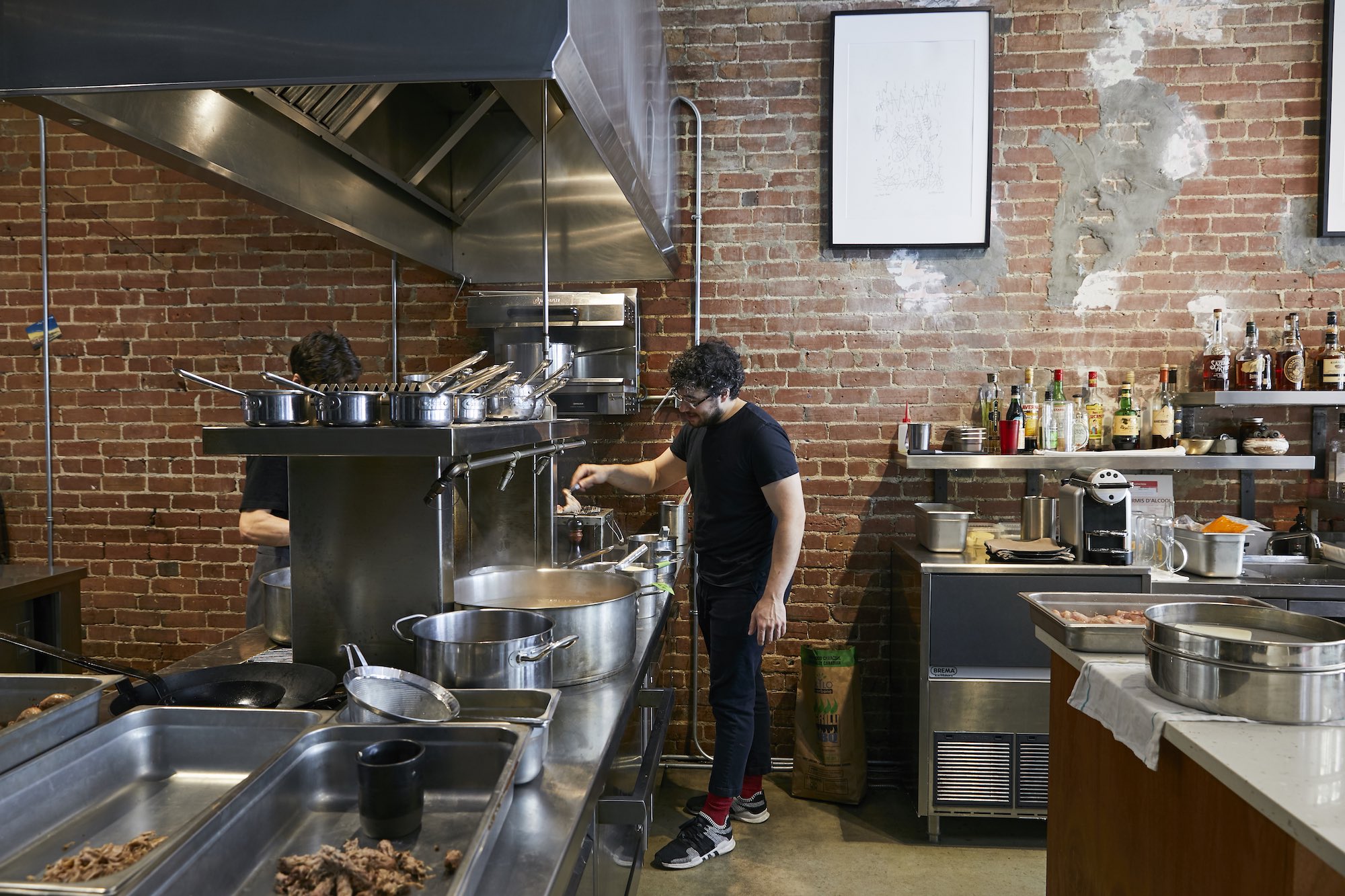
When it comes to ranges, you’ll have two options: Gas or electric.
Gas ranges
Gas ranges are known for their temperature control. These types of ranges start at your desired heat immediately and offer much more control than an electric range. Another plus? Gas ranges will keep on working even during a power outage. The downside? They are harder to clean and also come with a higher risk of a fire or gas leak.
Electric ranges
Electric ranges are known for their efficiency. They are easy to clean and can cook food more evenly than gas ranges. Opting for an electric range will also reduce the risk of a fire or gas leak in your kitchen. The cons? Electric ranges can rack up a hefty electricity bill.
Ventilation
Commercial kitchens can be an uncomfortable and crowded environment to work in. A ventilation system manages the airflow and temperature control all throughout your commercial restaurant kitchen, helping maintain a pleasant, clean and healthy environment for your staff.
When choosing your ventilation plan there are five factors you need to consider:
- Air volume flow rate: This is the rate at which air moves through your ducts. If you’re often grilling or cooking with an open flame you will require more ventilation than if you’re making pasta dishes.
- Static pressure: This is basically the resistance or friction against the air that moves through your ventilation system. Balancing the static pressure is key in making sure the air flows properly and energy isn’t wasted.
- Energy efficiency: Finding the right balance with your fan’s horsepower is key in achieving efficiency. If your fan’s motor is underpowered, it will wear out fast, but if it’s overpowered, you’ll run the risk of wasting too much energy.
- Size: Consider the size of your kitchen and how much space you have for a ventilation system. The placement of your fan will likely be decided based on available space or fire code safety requirements. This needs to be a key part of your commercial kitchen layout planning.
- Noise: Fans can be loud and can add a considerable amount of noise to an already loud kitchen. Fan loudness is calculated in “sones” and a commercial kitchen fan should be between 7 and 21 sones. Make sure to keep the loudness of the fan in consideration when choosing your ventilation system. Your employees will thank you.
3. Food processors
A food processor is a piece of kitchen equipment that can be used for chopping, slicing, shredding, grinding and pureeing different types of food. While there are many different types of food processors, there are four main types you should consider for your restaurant.
Batch bowl processor
Most commonly found in your house, it collects food as it’s processed. Kitchen staff can drop food vertically and choose the type of cut they want. With this type of processor, you can easily remove the bowl and empty its contents.
Continuous feed food processor
This type of processor allows you to constantly add food while it’s running and the processed food goes into a separate bowl—this is a great option for a commercial kitchen.
Buffalo choppers
Buffalo choppers are heavy-duty processors made of all-metal and can even process meat. This might not be necessary for most commercial kitchens.
Combination processors
A good middle point combines batch and continuous processors by using an attachment.
4. Mixers
If you are planning to make any bread or desserts, you need to invest in a commercial kitchen mixer. Select your mixer depending on the volume of food you’re planning to make and how often you will use it.
Floor mixers
This is one of the most popular types of mixers for a commercial setting. These models are high powered and can mix large amounts in a short amount of time. This is ideal for restaurants that are planning to use a mixer on a regular basis and at a high capacity.
Hand mixers
Also known as stick mixers or immersion blenders, these mixers are handheld and are great for blending things like soups and sauces. With this type of mixer, you can emulsify, chop or mix at high speeds.
Countertop mixers
Countertop mixers are the mixers you’re probably used to seeing in small bakeries, small restaurants or even in home kitchens. These are great if you don’t have a very high output and aren’t working with a lot of space.
5. Slicers
Just as the name suggests, slicers are a great tool for slicing things like meats and cheeses. While this might not be necessary for every restaurant kitchen, it will definitely come in handy if you plan on serving anything from sandwiches to cold cuts and charcuterie platters.
When purchasing your slicer, consider the following depending on the needs of your restaurant:
- Automatic or manual
- Blade size
- Horsepower
- Light, medium or heavy-duty
6. Food prep counters and cutting boards
Prep tables, counters and cutting surfaces are essential to your restaurant kitchen. Your staff will constantly be using it for different types of prep work, so you’ll need something that’s versatile and can last a long time.
For your prep counters, stainless steel is the way to go. These counters are sturdy, won’t absorb any bacteria and will withstand all the cleaning products you throw on them over and over again. On the line, be sure you have small refrigerators installed under your prep counters to keep things moving quickly.
As for your cutting boards, plastic will be your best bet. Plastic is not as porous as wood, making it harder for bacteria to hide in the cracks. Plastic cutting boards are easier to clean and dishwasher safe, and will help you prevent cross-contamination.
Pro tip: color-code your plastic cutting boards depending on the type of food you usually prepare on them.
7. Freezers and refrigerators
To keep your food fresh for as long as possible (and avoid any risk of food safety and health code violations) you need to invest in quality freezers and refrigerators.
First, you’ll want to consider the size and capacity of your restaurant and then the features. Ideally, you always want to opt for reach-in refrigerators—these are the most convenient for your staff. A walk-in cooler is also easy to use, safe and a great option if you have space and if your restaurant requires that much food storage.
Next, you’ll need to consider the condenser. A condenser basically helps regulate the temperature of your freezer or refrigerator. For a condenser, you can either choose a top or bottom-mounted refrigerator.
A top-mounted condenser is great at avoiding clogs and it doesn’t blow warm air into the fridge when opened. A bottom-mounted condenser is great in situations where cleaning and maintenance are the top priorities. These are often used in bakeries.
Taking the time to look for the best possible refrigerator or freezer for your restaurant will help ensure the quality of everything you cook. So make sure this piece of equipment is at the top of your list of priorities!
8. Safety equipment
You’ve already done the legwork of all of the restaurant licenses and permits you need, so you know that health and safety are priority number one in this business.
In order to ensure the safety of your staff and customers, make sure you stock up on the following essential safety items:
- Fire extinguishers
- First aid kits
- Rubber floor mats
- Wet floor signs
- Aprons
- Oven mitts
- Goggles
- Hairnets
- Security cameras
9. Storage racks and shelving
Every kitchen needs good shelving and storage for dry food, utensils and equipment. Your storage choices need to be strategic and durable. This is not something you want to have to change or replace, so choosing the right material the first time should be a priority.
When it comes to your storage or shelving, you have a wide variety of materials to choose from: Chrome wire, epoxy, coated, polymer, anti-microbial and stainless steel. Your choice will depend entirely on your budget, use and personal preference.
When you’re buying your storage racks, ask yourself this: Is mobility important to you? If so, consider opting for mobile storage racks instead of stationary, or a combination of both. You might need to move your storage from time to time and if so, this will come in handy.
Make sure to arrange your shelving in a way that makes sense and will allow your staff to find things easily and efficiently. Planning out your shelving and storage units is an important part of your commercial kitchen layout plan.
10. Cooking equipment
Who has time to stop and wash the tasting spoon in between dishes? Not your staff. The best way to think about your cooking equipment quantity is in a shift. What will you need to execute an entire shift without washing a dish?
Make sure you have ample amounts of the following items:
- Pots and pans (of all sizes) with lids
- Spoons for mixing and tasting
- Chef’s knives
- Mixing bowls
- Whisks
- Spatulas
- Ladles
- Tongs
- Baking pans
- Sheets and roasting pans
- Towels
- Rags
11. Servingware
Any good chef knows that you need the right dishes (and utensils) to plate and serve every type of food. You’re going to need to stock up on cutlery, bowls of all shapes and sizes, ramekins, cups and glasses. Take stock of the various sizes of platters and plates you’ll need and then consider breakage. Be prepared for any eventuality!
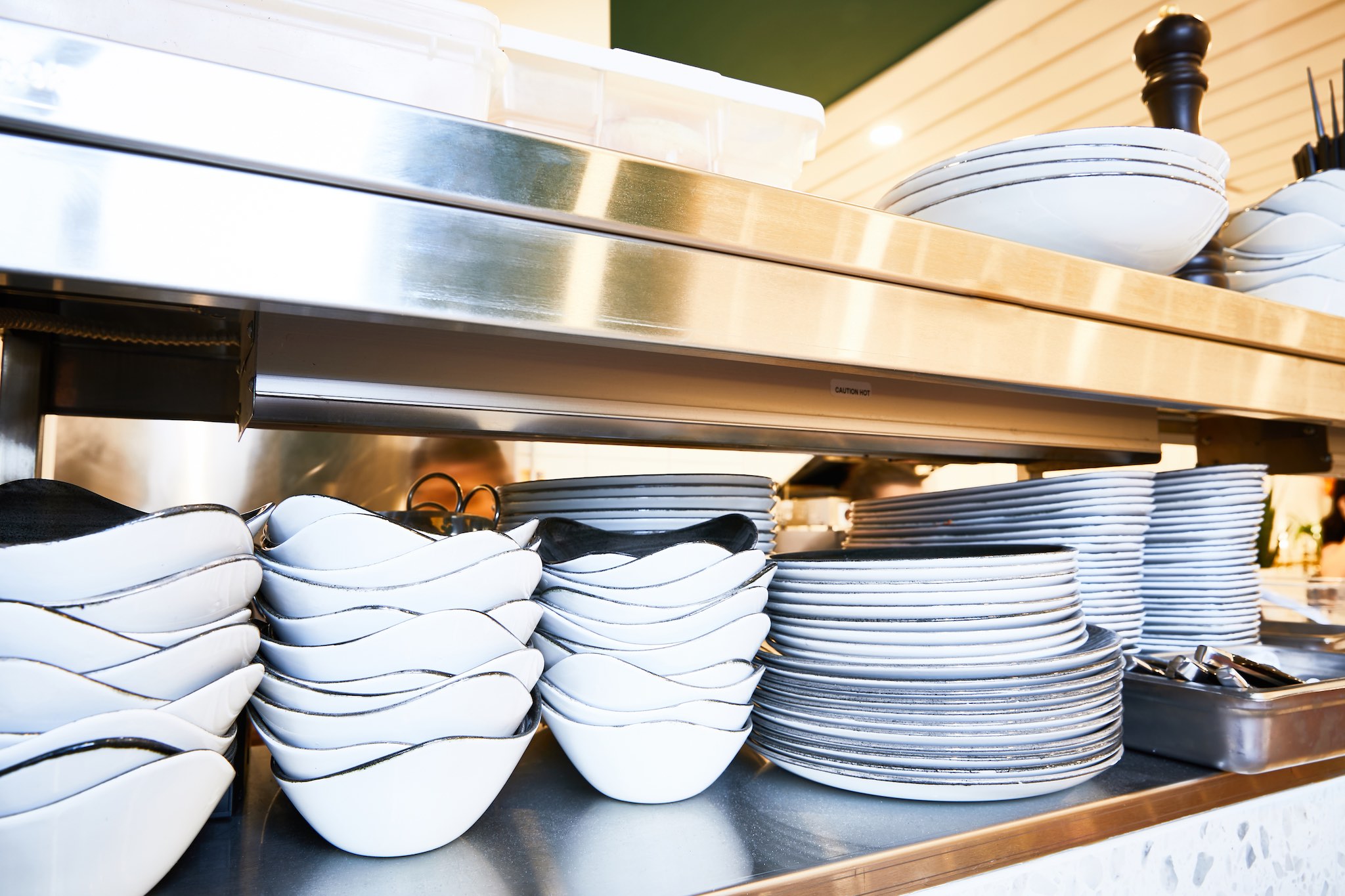
These are the main types of servingware you need to acquire for your restaurant:
- Dishware: plates, platters, bowls, serving plates and bowls.
- Glassware: wine, cocktail, beer, water, dessert and specialty glasses.
- Flatware: knives, spoons, forks, serving utensils
- Dinnerware accessories: charger plates, ramekins, sauce cups, dessert dishes, plate covers, bread and butter plates, coffee mugs, teacups and saucers.
- Displayware: baskets, appetizer and tasting dishes.
- Linens: cloth napkins and tablecloths.
The amount of servingware you should buy depends entirely on your restaurant size and the types of dishes you’re planning on serving.
Before ordering all your dishware ask yourself the following questions:
- What is your table turnover rate?
- How many seats are in your restaurant?
- What types of dishes are you serving?
- How many people do you expect on your busiest days and times?
- What are your most popular dishes?
- What types of dishware do those popular plates require?
This will help you make a better calculation of the amounts of each type of servingware you should buy.
12. Storage containers
A successful restaurant needs to be efficient at minimizing food waste. This means having the proper food storage containers and establishing best practices with your staff. Because of the different types of food used during the cooking process, it’s necessary to have an assortment of storage containers.
Make sure to stock up on:
- Vegetable crispers: great for keeping products fresh.
- Large ingredient bins: use these to store dry ingredients like flour in bulk.
- Kitchen canisters: useful for storing small amounts of ingredients like coffee or sugar.
- Dough boxes: these are made for storing unbaked dough and will come in handy if you’re planning on baking bread or desserts.
- Food storage containers: stock up on them in all shapes and sizes. You’ll never know when you’re going to need them.
Finally, stock up on things like masking tape and sharpies or a label maker. This will be useful whenever you’re labeling items or identifying their best-before date.
13. Sinks
Sinks are used for three main purposes in your restaurant: dishwashing, food preparation and hand washing. In general, to meet health and safety requirements, you will likely need a certain minimum number of sinks plus a commercial dishwashing machine.
Take a look at your respective country and region’s food regulations:
- United States Food and Drug Administration
- Canada Food Inspection Agency
- United Kingdom Food Standards Agency
These are different types of sinks you might need to take into account when building your commercial kitchen equipment list:
Compartment sinks
Compartment sinks come in a variety of sizes and can add versatility to your kitchen sink game. If you opt for multiple compartments, you can use each sink for a certain activity like rinsing vegetables or hand washing.
Bar sinks
This type of compartment sink is usually placed on a lower level for ease of use and is often used to empty drinks and many other functions. It’s also often equipped with a speed rack to allow easy access for your barback or bartender during drink prep.
Disposal sinks
These sinks come equipped with a waste disposal system. Make sure to keep the disposal system covered when it’s not being used.
Drop-in units
These units are placed onto an existing surface like a countertop.
Hand washing sinks
As the name states, these are generally smaller sinks with the main purpose of allowing staff to wash their hands, to not contaminate other sinks.
Mop sinks
Mop sinks are also known as janitorial sinks and are mainly used for filling buckets and draining mops. These can be set up on the floor.
Portable sinks
These can either be sinks with drains, without a faucet or handwashing carts with water tanks. These are mainly used by outdoor or mobile vendors.
14. Kitchen Display System (KDS)
Let’s face it, kitchens are busy. Yelling out orders and passing hand-written notes between the front and back of house can make a hectic night even more stressful and leaves room for plenty of mistakes. This makes kitchen display systems (KDS) a great add-on to your back-of-house restaurant hardware.
With a KDS, your back-of-house staff gets access to orders in real-time, without any confusion. Orders can be easily modified and displayed, giving your kitchen staff all the information they need to complete the order correctly, and on time.
With a KDS like Lightspeed’s, you can keep track of turnaround orders with ticket times, and color-code orders to see what’s cooking and what’s ready to go. This allows your staff to properly manage orders and stay on top of everything throughout the night. Your KDS replaces the need for printers and paper tickets, making your business more efficient and sustainable at the same time.
15. Point of sale system (POS)
A point of sale system (POS) is the hub of your restaurant operations and a key piece of restaurant kitchen equipment. You need it to keep track of everything from orders and transactions to customer relationship management and reporting.
Some of the restaurant hardware often used alongside a POS system includes things like receipt printers, kitchen printers, cash drawers, iPad stands and payment terminals.
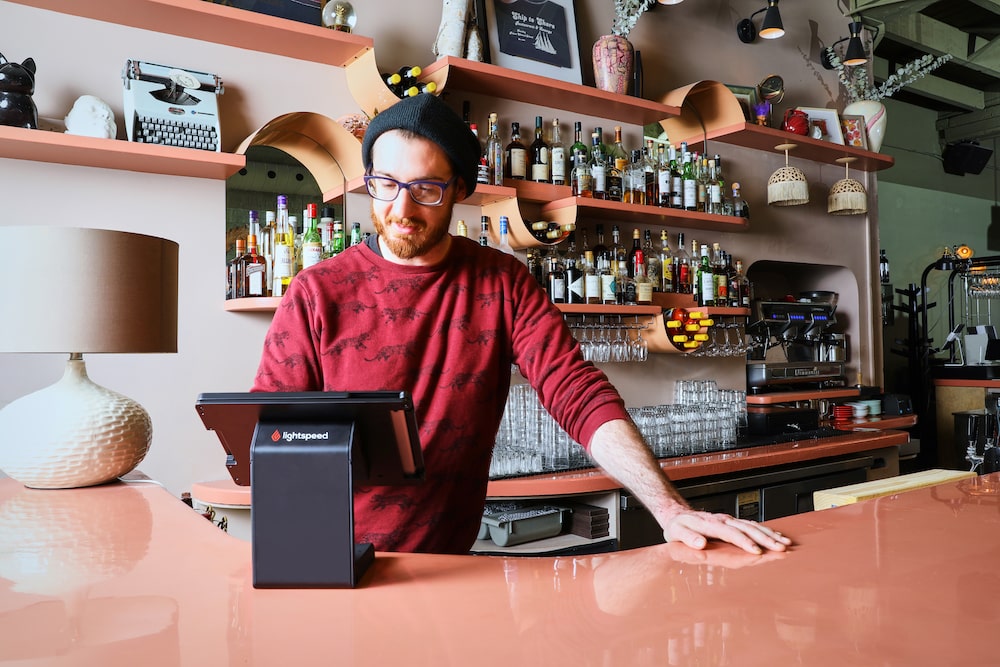
When looking for a POS, ask yourself the following questions to make sure it’s the best POS for you:
- Is it intuitive? A user-friendly POS that’s easy to learn will come in handy when you’re training staff. An intuitive system will keep your staff happy and minimize mistakes.
- Is it customizable? Not every restaurant is the same, and neither should your POS. Find a POS company that’s willing to work with your restaurant to make the POS your own.
- Does it offer offline features? Imagine your internet goes down. You’ll want a POS with a fully-featured offline mode that allows you to continue your service without interruption.
- Does it offer customer relationship management capabilities? Establishing a relationship with your customers is key for the success of your restaurant. Look for a POS with CRM capabilities like creating customer profiles, promotions and loyalty programs.
- Is it mobile? Offering the best service should be easy with your POS. You’ll want a cloud-based POS that will let you offer your customers on the spot service, no matter where they are seated.
- Does it offer multi-store capabilities? If you own multiple locations or you’re thinking of adding a second location, having a POS that can grow as you grow will make your life easier and make transitions seamless.
- Does it have payments embedded? Lightspeed Payments makes it easier than ever to serve guests and get paid, with one platform. With payments embedded, transactions are automatically recorded in your ePOS system, saving time and reducing errors because it eliminates the need for manual entry.
- Does it offer reporting? Knowing the numbers behind your business will help you make smarter business decisions. Find a POS that offers data like end of day reports, staff reports and more.
- Do they offer support? Let’s face it, the restaurant industry is full of curveballs. You’ll want a POS that offers 24/7 support when you need it most.
With Lightspeed, you can manage everything from tracking labor and handling transactions to customizing menus and creating customer profiles. Ideally, you want a POS that helps you work more efficiently, and not harder, allowing you more time for the things that matter most.
16. A steam table
To keep sauces and other prepped food warm throughout service, you’ll need a steam table. This will keep food in metal containers warm at a safe temperature for hours.
17. Washing equipment
Soap and water aren’t all you need when it comes to keeping your commercial kitchen clean.
Stock up on these products to ensure your kitchen is up to code every single shift:
- Brushes for your griddles
- Mops
- Sponges
- Rags
- Commercial-grade cleaning products
18. Sharpening stone
You’ve invested a ton of money into your kitchen utensils and everyone knows that the best knives work better when they are sharpest. To keep your knives in tip-top shape, you need to invest in sharpening stones. You may want to have more than one in the kitchen. This will ensure your prep staff can always chop, prep and do whatever they need with the best quality knives.
19. Microwave
With all the kitchen equipment needed to run a restaurant, microwaves are often forgotten. But odds are you are not going to be cooking every single thing in your kitchen from scratch and you will need a commercial microwave.
Microwaves will come in handy when it comes to steam cooking, reheating pre-cooked items or defrosting. Bottom line: you are going to need one.
20. Ice maker
Whether you’re serving drinks at the bar or making sure every guest has a cold glass of water when they sit down, you’re going to need a good ice machine. Look out for an ice machine that’s constantly dispensing ice right into a bin so it’s ready for your staff to use at all times.
21. Gas or electric grill
Everyone knows that the perfect steak or burger comes from a grill (also known as a griddle). The best ones come with an added flat griddle surface perfect for making pancakes or grilling sandwiches.
The main issue with choosing a grill for your restaurant will likely be space. If you have an outdoor terrace, you could opt for a commercial outdoor grill, but otherwise, you will likely be purchasing an indoor grill.
If having a grill is important for your type of cuisine, make sure to make the space for it when you’re planning out your restaurant layout.
Lifespan of restaurant kitchen equipment
How long your restaurant equipment lasts will depend on several factors. The frequency of use, cleaning, level of maintenance and quality will all affect your equipment lifespan. The more you take care of it, the longer it will last.
Although the duration and quality of equipment life can vary significantly, here are some general standards for estimating the lifespan of your restaurant equipment.
- Refrigerators and Freezers: These can last anywhere between 10 to 20 years depending on the quality, usage, and maintenance.
- Cooking Equipment: Ranges, ovens, grills, and fryers can last between 10 to 15 years. Frequent cleaning and preventative maintenance can prevent common causes of breakdowns such as build-up of grease.
- Dishwashers: Commercial dishwashers for restaurants generally have a lifespan of 7 to 12 years. Cleaning your dishwasher and filter regularly will help extend its lifespan.
- Small Appliances: Blenders, mixers and food processors will have a slightly shorter lifespan. These can last between 5 to 10 years depending on the quality and frequency of use.
You can extend your equipment’s lifespan with proper maintenance, cleaning and repair, saving you money in the long run.
Financing & buying kitchen tools and equipment
If you want to purchase your restaurant equipment outright but don’t want to hand over a large sum of money upfront, there are financing options available. If you have an established business in good standing, a traditional business loan may be available to you. However, depending on where you live, most traditional banks may not want to lend to someone without any successful business history to back it up, so you’ll have to go with an alternative such as a personal loan or line of credit.
Another option? Lightspeed Capital, the flexible funding built for your restaurant. Lightspeed Capital frees you from the constraints of traditional financial aid, so you can grow your business with easily accessible, renewable funding, whether you want to invest in new ovens or kitchen display screens.
Leasing vs. renting restaurant kitchen equipment
Restaurant equipment is pricey and the costs can add up quickly, especially when you have to buy all of the large appliances on top of the smaller items like utensils and safety equipment. To help with the costs, restaurant owners often look at the option of buying new versus buying used restaurant equipment. Like all things in this business, there are pros and cons to each option.
The pros of buying used commercial kitchen equipment for restaurants
This can include low cost due to depreciation—as soon as a stove leaves the showroom, like a car, it loses its value so even if it’s barely been used you can get a great deal. Additionally, due to the high rate of failure in this industry, it can be easy to find gently used equipment for restaurants for a great price.
The cons of buying used commercial kitchen equipment
Can include unforeseen damages and no warranty—you’re responsible for the damages there. Additionally, you have less of a selection and quantity when you opt for used.
When it comes to buying new versus used, consider priorities and keep in mind that some items are better to buy used (ovens) than others (freezers).
Where to buy restaurant equipment
There are a number of options available when it comes to buying restaurant kitchen equipment.
- Local restaurant supply stores. If you aren’t sure what brand or style of kitchen tools and equipment you are looking for, a salesperson at a local supply store can walk you through your options. If there are multiple restaurant supply stores in your area, you can shop around to find the best deals and make a more informed decision.
- Online stores. If you already know exactly what you want, you may want to save time driving around by ordering your kitchen equipment from an online supply store, such as Webstaurant Store or RestaurantSupply.com.
- Secondhand. To save money you may be thinking about purchasing some more expensive items secondhand. If you are purchasing from someone you don’t know via sites like Craigslist or Facebook Marketplace, make sure you are getting an item in good condition at a fair price. If you’re unsure what to look for, bring along a friend or colleague who knows what to look for.
What to consider before purchasing your kitchen tools and equipment
When deciding on the right equipment for your restaurant or kitchen, it is important to begin the process by considering the following four factors.
- Determine the type and volume of food you plan to serve
- Available space in your kitchen, as well as your budget
- Durability and reliability of the equipment
- Ensure the equipment complies with health and safety regulations
Doing your research as well as comparing and looking at reviews will be the best way to get started in looking for some higher-priced products like your refrigerator and oven. Knowing what you need ahead of time, and making a list of all the different pieces of equipment will help you concretize your needs if you need to apply for financing and loans.
Looking for best-in-class technology for your restaurant? Talk to one of our experts to find out how Lightspeed can help.

News you care about. Tips you can use.
Everything your business needs to grow, delivered straight to your inbox.
